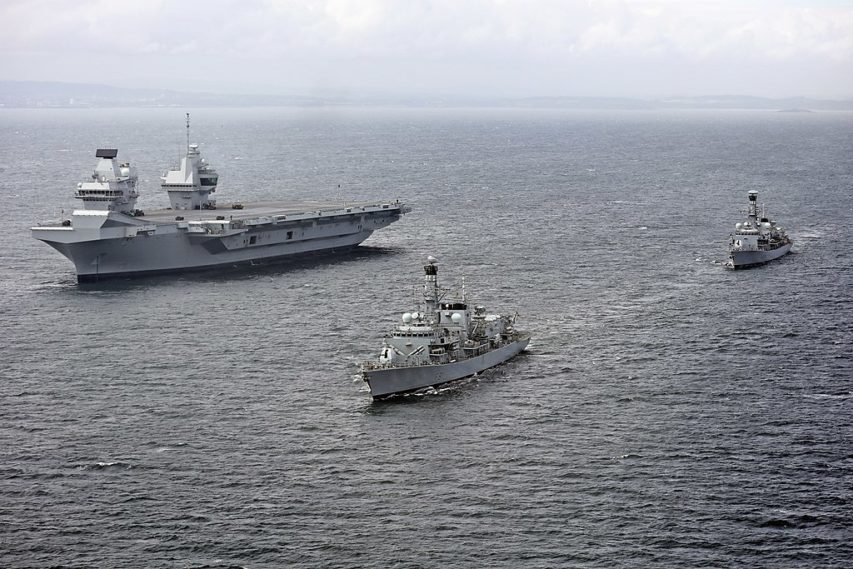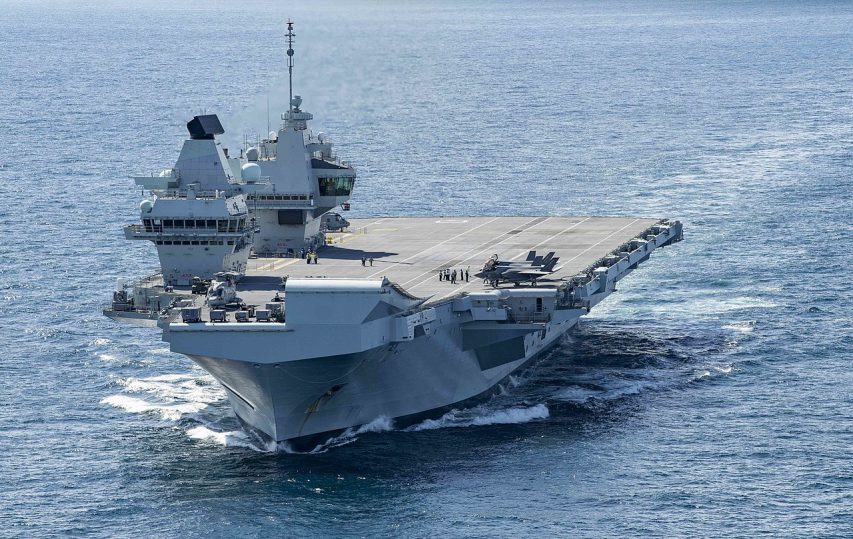UK Defence Journal reported a few days back that the Royal Navy’s new aircraft carrier will take on her first active deployment in 2021, including a possible Freedom of Navigation exercise (FONOPS) in the South China Sea:

Aerial view of HMS Queen Elizabeth with Type 23 frigates HMS Iron Duke (centre) and HMS Sutherland (right) in June 2017 off the coast of Scotland.
Photo by MOD via Wikimedia Commons.
Commodore Michael Utley, Commander United Kingdom Carrier Strike Group, is reported by Save The Royal Navy here as saying that HMS Queen Elizabeth will be escorted by two Type 45 destroyers, two Type 23 frigates, a nuclear submarine, a Tide-class tanker and RFA Fort Victoria.
The ship will also carry 24 F-35B jets, including US Marine Corps aircraft, in addition to a number of helicopters.
Prior to the deployment, it is understood that the Queen Elizabeth carrier strike group will go through a work-up trial off the west Hebrides range sometime in early 2021.
When asked about whether or not the UK has enough escorts to do this without impacting other commitment, Defence Secretary Ben Wallace said:
The size and the scale of the escort depends on the deployments and the task that the carrier is involved in. If it is a NATO tasking in the north Atlantic, for example, you would expect an international contribution to those types of taskings, in the same way as we sometimes escort the French carrier or American carriers to make up that.
It is definitely our intention, though, that the carrier strike group will be able to be a wholly UK sovereign deployable group. Now, it is probably not necessary to do that every single time we do it, depending on the tasking, but we want to do that and test doing it. Once we have done that, depending on the deployment, of course, we will cut our cloth as required.
Gareth Corfield expands on this in The Register:
Although the initial plan was for Britain’s biggest ever warship to sail through the South China Sea, which China claims as its own territory in defiance of international laws and norms, and despite claims from at least six other countries including Vietnam and the Philippines, this detail was noticeably absent from the UKDJ report.
Over 200 islands, also subject to disputes between China, Taiwan, Vietnam, Malaysia, and the Philippines, also lie in the area, which stretches across 3.5 million square kilometres and is visited by one-third of the world’s shipping traffic.
A US presence on the South China Sea deployment will be a useful political tool for the administration as a show of strength to China as well as asserting the right to freedom of navigation in the sea. In addition, it reinforces the idea that the UK supports US foreign policy – Queen Elizabeth is effectively replacing a US carrier on her Far Eastern tour as part of the superpower’s standing naval presence.
Of the jets aboard QE, around half will be supplied by the US Marine Corps, as has been reported for years.
The Dutch Navy will definitely join the deployment, most likely with a De Zeven Provinciën-class frigate – replacing one of the British Type 23 frigates in the mooted carrier battle group. Similarly, UKDJ reckons that an American destroyer will join the 2021 deployment (named Carrier Strike Group 21), freeing up a British Type 45 destroyer.

Royal Navy aircraft carrier HMS Queen Elizabeth (R08) underway in the Atlantic on 17 October 2019, participating in exercise “WESTLANT 19”. The first operational deployment for HMS Queen Elizabeth with No. 617 Squadron and a squadron of USMC Lockheed Martin F-35B Lightnings is planned for 2021.
Photo by Mass Communication Specialist 3rd Class Nathan T. Beard, US Navy, via Wikimedia Commons



